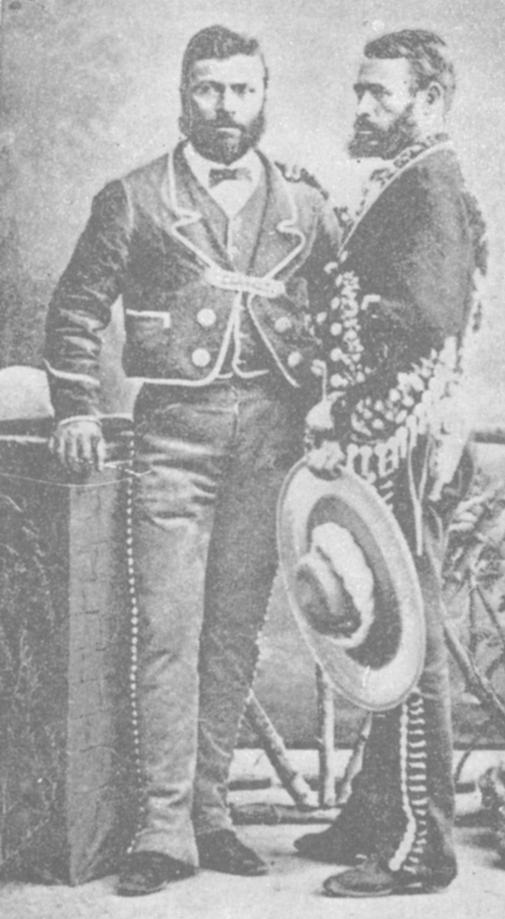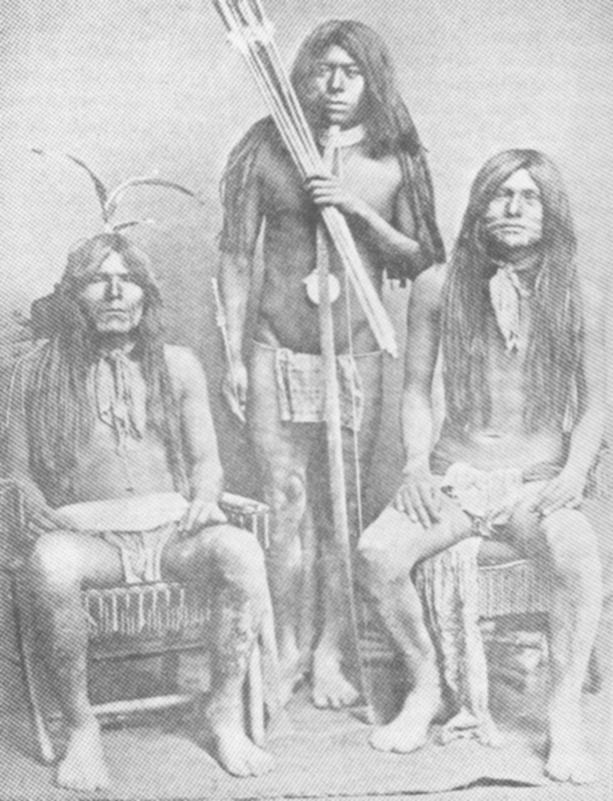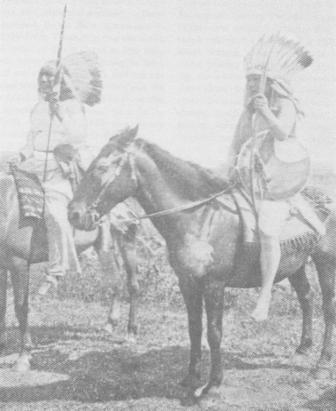SONS OF DEWITT COLONY TEXAS
© 1997-2001, Wallace L. McKeehan, All Rights Reserved
DeWitt Colony Defense and
Security
Marksmanship, Flying
Companies and Rangers. From its beginnings in the early 18th century on the
Spanish frontera and its vast area known as the despoblado, during colonization and the
years of Texas Independence, defense was a part of and integrated with daily activity.
Landowners organized "flying companies"
of local volunteers that in the late part of the century became more formally organized
units under command of professional officers who were representatives of centralized
government (companias volante). The Federalist structure of government in 1824 formalized
by decree that local militias were to be under command of local alcaldes and
ayuntamientos, properly armed and trained in cavalry methods, and responsible for regional
defense and security. The Colonization Laws of Coahuila y
Tejas of 1825 provided that the empresario was responsible for organization and
command of the militia of the colony at the rank of Colonel until the minimum 100 families
arrived to justify organization of an ayuntamiento.
 DeWitt Colonists
were superior marksman honed to perfection since wildgame provided a significant part of
their daily fare. Consequently, most were accustomed to infantry tactics in the open
field or largely defensive strategies behind thick woodland cover. Hispanic Tejano
patriot Antonio Manchaca pointed out in his
memoirs referring to skirmishes which preceded the main Battle of San Jacinto that DeWitt Colonists
were superior marksman honed to perfection since wildgame provided a significant part of
their daily fare. Consequently, most were accustomed to infantry tactics in the open
field or largely defensive strategies behind thick woodland cover. Hispanic Tejano
patriot Antonio Manchaca pointed out in his
memoirs referring to skirmishes which preceded the main Battle of San Jacinto that
"Houston gave orders that those men who
lived upon the Navidad and Lavaca and killed deer at a hundred paces offhand should come
forward and take a shot at the Mexicans. Immediately about fifty men were formed in
line and went to a good distance from where the Mexicans were, fired one volley and hushed
them."
There were exceptions, for example, the author’s
ancestors, David Burket and Captain "Black" Adam Zumwalt,
were skilled cavalryman who served in Captain Nathan Boone’s Company of Rangers in
Missouri before immigrating to the colony. Out of necessity, DeWitt Colonists learned,
adopted and combined their skills in marksmanship with the skills and tactics employed in
the vast open plains by native Texan citizen soldiers and militia since the early 18th
century. The unparalleled skills, tactics and traditions of the Tlascalan
Compania Volante San Carlos de Parras, the Guardia Victoriana under Carlos de la
Garza, the San Fernando Rangers under Mariano Rodriquez,
Bexar squadrons under Juan Seguin and Salvador Flores and the Nacogdoches Vicente Cordova
squadron became the template for the Gonzales Ranging Company of Mounted Volunteers and
later the Texas Rangers. The "hit-and-run", "element of surprise" and
guerilla tactics of the mounted plains Indians, particularly the Comanches, which the
colonists encountered were also combined with the above skills to no small extent.
James W. Nichols in his journal describes the routine training sessions
for rangers near Seguin in Capt. Jack Hay's company in 1843:
We put up a post about the size of a common man, then put up another
about 40 yards farther on. We would ran our horses full speed and discharge our rifles at
the first post, draw our pistles and fire at the second. At first thare was some wild
shooting but we had not practised two months until thare was not many men that would not
put his balls in the center of the posts. Then we drew a ring about the size of a mans
head and soon every man could put both his balls in the circul. We would practics this
awhile, then try rideing like the Comanche Indians. After practisng for three or four
months we became so purfect that we would ran our horses half or full speede and pick up a
hat, a coat, a blanket, or rope, or even a silver dollar, stand up in the saddle, throw
ourselves on the side of our horses with only a foot and a hand to be seen, and shoot our
pistols under the horses neck, rise up and reverse, etc.
Captain William Banta in his memoirs Twenty-seven Years on the Texas
Frontier describes a typical ranger scout in the period:
It was in the spring of 1840, while living at Clarksville, that I
witnessed the first equipped scout ready to start after Indians. It was in the month of
May when it became necessary to call the citizens together to follow a party of Indians
who had made their way down into the settlements near Ward's Prairie, and had collected a
large herd of horses. Captain Denton called together all of the available men that could
go to follow the Indians. Their rations were as follows: each man was to provide himself
with ten pounds of coal flour, which was prepared in the following manner: Corn was taken
and shelled into a large kettle half full of sifted ashes, and set on a fire and stirred
until perfectly brown; it was then taken off and the ashes sifted out, and when the
parched corn was cool it was ground in a hand mill into meal, then salted to taste, and
put in a sack made for the purpose. The next item was coffee, parched and ground, put in a
sack; also salt and two days' rations of fresh baked bread, as the bread would not keep
longer than two days. Bedding consisted of two blankets to the man. The next thing was to
mould plenty of bullets or prepare suitable shot, for some had rifles and some shot guns,
mostly of the flint and steel order. A huge butcher knife was fastened in the belt. There
were no such arms as winchesters or cartridge pistols in those days; not even so much
as.cap and ball six-shooters, and but few cap locks for guns or pistols. The men being
thus provided, they were divided into messes of five men to the mess, and each mess had
one pack horse to carry provisions and blankets, also camping utensils and cooking
vessels. Forty men thus equipped were mounted with. Captain Denton in command, and now
ready to pursue the Indians, after bidding their friends farewell, as was the custom.
Captain Denton's little boy, called Bunion, ran to his father and said, "Dood bye
papa; don't let de Ingin dit your scalp."
Military
events leading to and including Texas Independence 1832-1836
Specific Indian Encounters, Depredations and Tales
 Indian
Vandalism and Depredation. During the period of colonization before troubles
began to mount with the centralist dictatorship which took over the Mexican government in
1835, life in the colony was generally peaceful allowing colonists to contend with the
natural hurdles of building a new society. From its beginnings as the eastern and northern
frontier of New Spain and Mexico and the western frontier of the United States until the
Texas Revolution, DeWitt Colony defense was concerned with the random vandalism, theft and
associated attacks on life and property of predatory bands of Indians and to a lesser
extent, outlaws from the south and east who roamed and exploited the vast despoblado for
subsistence. Overall DeWitt Colonists shared the bounty of the land in peace with the
indigenous populations who had used it for their nomadic hunting grounds, only taking
organized punitive action in response to the most savage acts of assault on life and
property. In the colony and all of Texas in the period, total contact with Indians was
limited and of low probability. At the peak in 1822, the highest number of Indians ranging
between the Red and the Rio Grande Rivers at any one time ever to other inhabitants was
one in seventy. It is estimated that during the period 1825 to 1836, no more than 100
persons died in confrontations with Indians in regions surrounding San Antonio, Goliad and
the DeWitt Colony combined. The randomness of acts of vandalism and extreme savagery of
the relatively rare depredations caused an aura of terror and fear in the period and
amplification in subsequent histories out of proportion to the actual danger and number of
incidents. However, the geographic location of the DeWitt Colony in the path of different
tribal bands ranging through from different directions caused the colony to sustain more
random harassment than other settlements of the period and to witness near their homes the
violent inter-tribal encounters among ancient enemy bands that was more fierce than
attacks on the colonists. Indian
Vandalism and Depredation. During the period of colonization before troubles
began to mount with the centralist dictatorship which took over the Mexican government in
1835, life in the colony was generally peaceful allowing colonists to contend with the
natural hurdles of building a new society. From its beginnings as the eastern and northern
frontier of New Spain and Mexico and the western frontier of the United States until the
Texas Revolution, DeWitt Colony defense was concerned with the random vandalism, theft and
associated attacks on life and property of predatory bands of Indians and to a lesser
extent, outlaws from the south and east who roamed and exploited the vast despoblado for
subsistence. Overall DeWitt Colonists shared the bounty of the land in peace with the
indigenous populations who had used it for their nomadic hunting grounds, only taking
organized punitive action in response to the most savage acts of assault on life and
property. In the colony and all of Texas in the period, total contact with Indians was
limited and of low probability. At the peak in 1822, the highest number of Indians ranging
between the Red and the Rio Grande Rivers at any one time ever to other inhabitants was
one in seventy. It is estimated that during the period 1825 to 1836, no more than 100
persons died in confrontations with Indians in regions surrounding San Antonio, Goliad and
the DeWitt Colony combined. The randomness of acts of vandalism and extreme savagery of
the relatively rare depredations caused an aura of terror and fear in the period and
amplification in subsequent histories out of proportion to the actual danger and number of
incidents. However, the geographic location of the DeWitt Colony in the path of different
tribal bands ranging through from different directions caused the colony to sustain more
random harassment than other settlements of the period and to witness near their homes the
violent inter-tribal encounters among ancient enemy bands that was more fierce than
attacks on the colonists.
 After
independence, the area that was the DeWitt Colony continued to experience isolated acts of
vandalism, theft and depredation from primarily nomadic Comanche bands from the hill
country and West and North Texas, which intensified with their recruitment by the Mexican
government in attempts to take back Texas. This culminated with the massive Comanche
raid on Linnville on the coast in which the force unified from
otherwise nomadic bands traveled through the former colony and back toward the hill
country. The massive defeat of the force at the Battle of
Plum Creek in 1840 was a turning point after which the serious threat from Comanches
and aborigine bands to the area ended. After
independence, the area that was the DeWitt Colony continued to experience isolated acts of
vandalism, theft and depredation from primarily nomadic Comanche bands from the hill
country and West and North Texas, which intensified with their recruitment by the Mexican
government in attempts to take back Texas. This culminated with the massive Comanche
raid on Linnville on the coast in which the force unified from
otherwise nomadic bands traveled through the former colony and back toward the hill
country. The massive defeat of the force at the Battle of
Plum Creek in 1840 was a turning point after which the serious threat from Comanches
and aborigine bands to the area ended.
Defense
and security in the Texas Republic 1836-1846.
DeWitt Colony Defense
and Security-Index
SONS OF DEWITT
COLONY TEXAS
© 1997-2001, Wallace L. McKeehan, All Rights Reserved |
 DeWitt Colonists
were superior marksman honed to perfection since wildgame provided a significant part of
their daily fare. Consequently, most were accustomed to infantry tactics in the open
field or largely defensive strategies behind thick woodland cover. Hispanic Tejano
patriot
DeWitt Colonists
were superior marksman honed to perfection since wildgame provided a significant part of
their daily fare. Consequently, most were accustomed to infantry tactics in the open
field or largely defensive strategies behind thick woodland cover. Hispanic Tejano
patriot  Indian
Vandalism and Depredation. During the period of colonization before troubles
began to mount with the centralist dictatorship which took over the Mexican government in
1835, life in the colony was generally peaceful allowing colonists to contend with the
natural hurdles of building a new society. From its beginnings as the eastern and northern
frontier of New Spain and Mexico and the western frontier of the United States until the
Texas Revolution, DeWitt Colony defense was concerned with the random vandalism, theft and
associated attacks on life and property of predatory bands of Indians and to a lesser
extent, outlaws from the south and east who roamed and exploited the vast despoblado for
subsistence. Overall DeWitt Colonists shared the bounty of the land in peace with the
indigenous populations who had used it for their nomadic hunting grounds, only taking
organized punitive action in response to the most savage acts of assault on life and
property. In the colony and all of Texas in the period, total contact with Indians was
limited and of low probability. At the peak in 1822, the highest number of Indians ranging
between the Red and the Rio Grande Rivers at any one time ever to other inhabitants was
one in seventy. It is estimated that during the period 1825 to 1836, no more than 100
persons died in confrontations with Indians in regions surrounding San Antonio, Goliad and
the DeWitt Colony combined. The randomness of acts of vandalism and extreme savagery of
the relatively rare depredations caused an aura of terror and fear in the period and
amplification in subsequent histories out of proportion to the actual danger and number of
incidents. However, the geographic location of the DeWitt Colony in the path of different
tribal bands ranging through from different directions caused the colony to sustain more
random harassment than other settlements of the period and to witness near their homes the
violent inter-tribal encounters among ancient enemy bands that was more fierce than
attacks on the colonists.
Indian
Vandalism and Depredation. During the period of colonization before troubles
began to mount with the centralist dictatorship which took over the Mexican government in
1835, life in the colony was generally peaceful allowing colonists to contend with the
natural hurdles of building a new society. From its beginnings as the eastern and northern
frontier of New Spain and Mexico and the western frontier of the United States until the
Texas Revolution, DeWitt Colony defense was concerned with the random vandalism, theft and
associated attacks on life and property of predatory bands of Indians and to a lesser
extent, outlaws from the south and east who roamed and exploited the vast despoblado for
subsistence. Overall DeWitt Colonists shared the bounty of the land in peace with the
indigenous populations who had used it for their nomadic hunting grounds, only taking
organized punitive action in response to the most savage acts of assault on life and
property. In the colony and all of Texas in the period, total contact with Indians was
limited and of low probability. At the peak in 1822, the highest number of Indians ranging
between the Red and the Rio Grande Rivers at any one time ever to other inhabitants was
one in seventy. It is estimated that during the period 1825 to 1836, no more than 100
persons died in confrontations with Indians in regions surrounding San Antonio, Goliad and
the DeWitt Colony combined. The randomness of acts of vandalism and extreme savagery of
the relatively rare depredations caused an aura of terror and fear in the period and
amplification in subsequent histories out of proportion to the actual danger and number of
incidents. However, the geographic location of the DeWitt Colony in the path of different
tribal bands ranging through from different directions caused the colony to sustain more
random harassment than other settlements of the period and to witness near their homes the
violent inter-tribal encounters among ancient enemy bands that was more fierce than
attacks on the colonists.  After
independence, the area that was the DeWitt Colony continued to experience isolated acts of
vandalism, theft and depredation from primarily nomadic Comanche bands from the hill
country and West and North Texas, which intensified with their recruitment by the Mexican
government in attempts to take back Texas. This culminated with the massive Comanche
After
independence, the area that was the DeWitt Colony continued to experience isolated acts of
vandalism, theft and depredation from primarily nomadic Comanche bands from the hill
country and West and North Texas, which intensified with their recruitment by the Mexican
government in attempts to take back Texas. This culminated with the massive Comanche